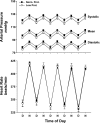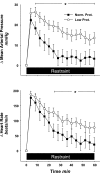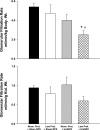Maternal protein restriction leads to hyperresponsiveness to stress and salt-sensitive hypertension in male offspring
- PMID: 20200128
- PMCID: PMC2867525
- DOI: 10.1152/ajpregu.00848.2009
Maternal protein restriction leads to hyperresponsiveness to stress and salt-sensitive hypertension in male offspring
Abstract
Low birth weight humans often exhibit hypertension during adulthood. Studying the offspring of rat dams fed a maternal low-protein diet is one model frequently used to study the mechanisms of low birth weight-related hypertension. It remains unclear whether this model replicates key clinical findings of hypertension and increased blood pressure responsiveness to stress or high-salt diet. We measured blood pressure via radiotelemetry in 13-wk-old male offspring of maternal normal- and low-protein dams. Neither group exhibited hypertension at baseline; however, 1 h of restraint was accompanied by a significantly greater blood pressure response in low-protein compared with normal-protein offspring. To enhance the effect of a high-salt diet on blood pressure, normal- and low-protein offspring underwent right uninephrectomy, while controls underwent sham surgery. After 5 weeks on a high-salt diet (4% NaCl), mean arterial pressure in the Low-Protein+Sham offspring was elevated by 6 +/- 2 mmHg (P < 0.05 vs. baseline), while it remained unchanged in the normal-protein offspring. In the two uninephrectomized groups, blood pressure increased further, but was of similar magnitude. Glomerular filtration rate in the low-protein uninephrectomized offspring was 50% less than that in normal-protein offspring with intact kidneys. These data indicate that, while male low-protein offspring are not hypertensive during young adulthood, their blood pressure is hyperresponsive to restraint stress and is salt sensitive, and their glomerular filtration rate is more sensitive to hypertension-causing insults. Collectively, these may predispose for the development of hypertension later in life.
Figures





Similar articles
-
Prenatal high-salt diet in the Sprague-Dawley rat programs blood pressure and heart rate hyperresponsiveness to stress in adult female offspring.Am J Physiol Regul Integr Comp Physiol. 2007 Jul;293(1):R334-42. doi: 10.1152/ajpregu.00887.2006. Epub 2007 May 9. Am J Physiol Regul Integr Comp Physiol. 2007. PMID: 17491116
-
Does a nephron deficit in rats predispose to salt-sensitive hypertension?Kidney Blood Press Res. 2004;27(4):239-47. doi: 10.1159/000079868. Epub 2004 Jul 20. Kidney Blood Press Res. 2004. PMID: 15273426
-
High-protein nutrition during pregnancy and lactation programs blood pressure, food efficiency, and body weight of the offspring in a sex-dependent manner.Am J Physiol Regul Integr Comp Physiol. 2006 Oct;291(4):R1025-30. doi: 10.1152/ajpregu.00898.2005. Epub 2006 May 4. Am J Physiol Regul Integr Comp Physiol. 2006. PMID: 16675628
-
Maternal undernutrition and the offspring kidney: from fetal to adult life.Braz J Med Biol Res. 2010 Nov;43(11):1010-8. doi: 10.1590/s0100-879x2010007500113. Epub 2010 Oct 29. Braz J Med Biol Res. 2010. PMID: 21049242 Review.
-
Sex differences in the fetal programming of hypertension.Gend Med. 2008;5 Suppl A(Suppl A):S121-32. doi: 10.1016/j.genm.2008.03.012. Gend Med. 2008. PMID: 18395678 Free PMC article. Review.
Cited by
-
Excess sucrose intake during pregnancy programs fetal brain glucocorticoid receptor expression in female but not male C57Bl/6J mice.Obes Sci Pract. 2021 Apr 9;7(4):462-472. doi: 10.1002/osp4.506. eCollection 2021 Aug. Obes Sci Pract. 2021. PMID: 34401204 Free PMC article.
-
Developmental programming of hypertension and kidney disease.Int J Nephrol. 2012;2012:760580. doi: 10.1155/2012/760580. Epub 2012 Nov 28. Int J Nephrol. 2012. PMID: 23251800 Free PMC article.
-
Paternal body mass index (BMI) is associated with offspring intrauterine growth in a gender dependent manner.PLoS One. 2012;7(5):e36329. doi: 10.1371/journal.pone.0036329. Epub 2012 May 3. PLoS One. 2012. PMID: 22570703 Free PMC article.
-
The magnitude of nephron number reduction mediates intrauterine growth-restriction-induced long term chronic renal disease in the rat. A comparative study in two experimental models.J Transl Med. 2016 Nov 30;14(1):331. doi: 10.1186/s12967-016-1086-3. J Transl Med. 2016. PMID: 27899104 Free PMC article.
-
Prenatal Programming and Epigenetics in the Genesis of the Cardiorenal Syndrome.Cardiorenal Med. 2011;1(4):243-254. doi: 10.1159/000332756. Epub 2011 Oct 12. Cardiorenal Med. 2011. PMID: 22096456 Free PMC article.
References
-
- Adair LS, Cole TJ. Rapid child growth raises blood pressure in adolescent boys who were thin at birth. Hypertension 41: 451–456, 2003 - PubMed
-
- Alexander BT, Hendon AE, Ferril G, Dwyer TM. Renal denervation abolishes hypertension in low-birth-weight offspring from pregnant rats with reduced uterine perfusion. Hypertension 45: 754–758, 2005 - PubMed
-
- Alwasel SH, Ashton N. Prenatal programming of renal sodium handling in the rat. Clin Sci (Lond) 117: 75–84, 2009 - PubMed
-
- Ashton N, Al-Wasil SH, Bond H, Berry JL, Denton J, Freemont AJ. The effect of a low-protein diet in pregnancy on offspring renal calcium handling. Am J Physiol Regul Integr Comp Physiol 293: R759–R765, 2007 - PubMed
Publication types
MeSH terms
Substances
Grants and funding
LinkOut - more resources
Full Text Sources
Medical

